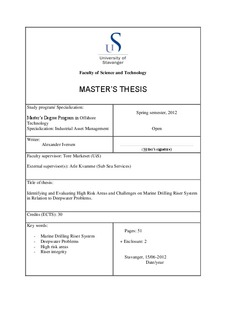| dc.contributor.author | Iversen, Alexander | |
| dc.date.accessioned | 2012-10-15T12:37:41Z | |
| dc.date.available | 2012-10-15T12:37:41Z | |
| dc.date.issued | 2012 | |
| dc.identifier.uri | http://hdl.handle.net/11250/182882 | |
| dc.description | Master's thesis in Offshore technology | no_NO |
| dc.description.abstract | The main concerns during drilling operations are riser integrity and maintaining well control. This thesis has mainly been focusing on the problems and challenges faced with the marine riser system to illuminate high risk areas related to riser integrity.
A marine riser system consists generally of four main elements; the upper marine riser package, riser joints, lower marine riser package, and the blowout preventer, each playing an important part in the marine riser system. The marine riser function is to supports and guide the auxiliary lines used to control the well, and connect and provide for fluid communication between the drilling vessel and the wellhead.
Failure to the marine riser is related to technical problems associated with old design and lack of correct operating procedure and maintenance method. Elements like the telescopic joint haven’t change the design since the 1960’s and are exposed to problems like unplanned discharge caused of premature war to the packer element. Problems with the telescopic joint are not unique there are also experienced failure with tensioner system, flex joint and blowout preventer. Studies show that blowout preventer failure cases the longest downtime and most expensive repairs. Over 50% of blowout preventer failures are related to the control system and are caused by failure to the hydraulic components.
Exploration activity forces the drilling contractor further out and into deeper water depths, like the Gulf of Mexico or outside the Coast of Brazil. Greater water depths challenge the riser system on many places. Deepwater operations means harsher environment and problems in the forms of large waves, strong currents and increased pressure from the water column, all affecting the operations and riser pipe in several ways. The environmental issues causes the riser to fail due to increased tensile load, vortex induced vibrations, environmentally induced cracks and increased corrosion attacks. The increased tensile load on the riser pipe place importance on the top tension capacity of the rig and the riser pipe wall thickness. Moving into deeper ground, many rigs reach their tension capacity and must use buoyancy modules to provide sufficient tension to the riser.
Many of the problems could be addressed using simple solution, like implementing correct maintenance program or address the issues in the design phase. But economical impetus holds the development back. Solutions like redesign of the telescopic joint and blowout preventer is advised by operators, but some of the solution are proven to be economical unprofitable. | no_NO |
| dc.language.iso | eng | no_NO |
| dc.publisher | University of Stavanger, Norway | no_NO |
| dc.relation.ispartofseries | Masteroppgave/UIS-TN-IKM/2012; | |
| dc.subject | offshore teknologi | no_NO |
| dc.subject | marine drilling riser system | no_NO |
| dc.subject | high risk areas | no_NO |
| dc.subject | riser integrity | no_NO |
| dc.title | Identifying and evaluating high risk areas and challenges on marine drilling riser system in relation to deepwater problems | no_NO |
| dc.type | Master thesis | no_NO |
| dc.subject.nsi | VDP::Technology: 500::Marine technology: 580::Offshore technology: 581 | no_NO |
| dc.source.pagenumber | 52 | no_NO |
